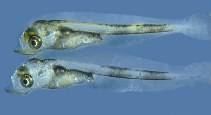| FishBase |
Larvae Information Summary for
Gadus morhua

| Main Ref: | Russell, F.S. 1976 | |||
Yolk-sac larvae
| max | min | mod | Ref. | |
| Length at birth (mm) | 5.71 | 3.3 | ||
| Preanal L. % TL | 37.6 | 34.8 | 35.3 |
| Place of development | planktonic | |||
| Larval area | Northeastern Atlantic (British coasts); Northwestern Atlantic (Delaware Bay) | |||
| Yolk-sac | ovoid unpigmented | Ref: | ||
| Yolk | unsegmented | Oil globules | no oil globule | |
| Rows on tail | no rows | |||
| Other melanophores on tail | two dorso-ventral clusters or bands | |||
| Melanophores on head + trunk | melanophores on head + trunk | |||
| Two postanal bars (Ref. 37). Three ventral accumulations of pigment on tail, including one on notochord tip; two dorsal accumulations of pigment on tail; ventral accumulations longer than dorsal and extend farther posteriorly (Ref. 68). Vent opens at side of finfold (not at margin); gut short and coiled (Ref. 68). | ||||
Post larvae
| Striking feature | none | |||
| Striking shape lateral | normal (not striking) | dorsal | normal (not striking) | |
| Striking feature | none | |||
| Shape of gut | triangular | |||
| Gas bladder early | invisible | late | invisible | |
| Spinal armature early | no spines | late | no spines | |
| Pigmentation early | ||||
| Rows on tail | dorsal + ventral row | |||
| Other melanophores on tail | tail with single melanophore | |||
| Melanophores on head + trunk | melanophores on head + trunk | |||
| Pigmentation late | ||||
| Rows on tail | dorsal + lateral + ventral row | |||
| Other melanophores on tail | tail partly covered with melanophores | |||
| Melanophores on head + trunk | melanophores on head + trunk | |||
| Urostyle region early | pigmented | late | pigmented | |
| Peritoneum | covered with melanophores | |||
| Pectorals | normal without melanophores | |||
| Pelvics | normal (i.e. small or absent) without melanophores | |||
| Yolk sac absorbed at about 4.5 mm (Ref. 7135). Lancet-shaped base of caudal fin. 1 to 3 ventral caudal melanophores. The ventral row of melanophores generally extends farther back than the dorsal (in contrast to G. virens) (Ref. 37). Pelvic fins thoracic, elongate; no head spines present during larval development (Ref. 68). Young 15.0 to 30.0 mm recognizable by vent under 2nd dorsal fin and dense pigmentation. Pigmentation: pigment patterns usually well-developed at hatching (Ref. 68). At 7.0 to 10.0 mm, pigment bars fuse and a median band forms. At 10.0 to 20.0 mm, pigment extends to the tail. Sequence of fin formation: At 20.0 mm, dorsal and anal fins have full complement of rays. | ||||
Meristic characters
| max | min | mod | Ref. | |
| Total number of vertebrae | 20 | 17 | 18 | 39467 |
| L 1st feeding | Ref. |
Months of presence of larvae
|
||||
| max | 5.1 | Jan | Feb | Mar | Apr | |
| min | 4.5 | May | Jun | Jul | Aug | |
| mod | 4.8 | Sep | Oct | Nov | Dec | |
| Water parameters Metric characters |
| Back to Search |